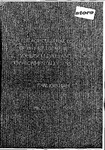THE AGRICULTURAL ECOLOGY OF HAY MEADOWS WITHlN THE SOMERSET LEVELS AND MOORS ENVIRONMENTALLY SENSITIVE AREA
| dc.contributor.author | KIRKHAM, FRANCIS WILLIAM | |
| dc.contributor.other | School of Geography, Earth and Environmental Sciences | en_US |
| dc.date.accessioned | 2012-08-09T08:40:22Z | |
| dc.date.available | 2012-08-09T08:40:22Z | |
| dc.date.issued | 1996 | |
| dc.identifier | Not available | en_US |
| dc.identifier.uri | http://hdl.handle.net/10026.1/1126 | |
| dc.description.abstract |
Ecologicai and productivity responses to agricultural management were studied over eiglit years in species-ricii hay meadows within a Site of Special Scientific Interest on a Somerset peat moor. The vegetation typified that of many wet meadows on the Somerset Levels and elsewhere, definable as MG5 {Cynosurus cristatus-Centaurea nigra meadow) and MG8 {Cynosurus cristatus-Caittia palustris flood pasture) within the National Vegetation Classification. The effects of inorganic fertilizers on species diversity, soil nitrogen loss and agricultural productivity (hay yield and beef production during aftermath grazing), were investigated during 1986-90. These data were subsequently analyzed for the effects of variations in water table depth on productivity and soil N losses. Further studies in 1991-93 covered: (a) soil seed bank composition in relation to above ground vegetation; (b) the effect of different cutting dates on seed rain, vegetation composition and herbage yield and quality; and (c) seed shedding as influenced by hay making operations. The vegetation was sensitive to even small fertilizer inputs, particularly of P and K, both in terms of increased productivity and reduced botanical diversity. Species diversity also declined on unfertilized plots in one experiment, after a change from aftermath grazing to cutting only. Leaching and denitrification of soil N following N application were both high compared with soils elsewhere, due to the high water table. Fertilizers caused a four-fold shift in soil seed bank composition towards nitrophilous species and increased the ratio of short-term to long-term persistent species. Cutting in May or September affected both the total seed rain and the balance of species represented and significantly reduced vegetation diversity, compared with cutting in July or August. The thesis includes an extensive literature review and the results are discussed in the context of (a) current theories on the relationships between species diversity, soil fertility, disturbance and productivity, and (b) hay meadow management within Environmentally Sensitive Areas. It is concluded that production response to fertilizers is not constrained by the species richness of the vegetation, but there is no scope for increasing soil fertility without reducing species diversity. Nitrate leaching risk is increased with N rates above about 75 kg ha'^ year"^ at ambient water table levels, but no N should be applied where high water tables are maintained. Occasional cutting after July is necessary to allow most species to set seed and to maintain a persistent soil seed bank. | en_US |
| dc.description.sponsorship | Institute of Grassland and Environmental Research | en_US |
| dc.language.iso | en | en_US |
| dc.publisher | University of Plymouth | en_US |
| dc.title | THE AGRICULTURAL ECOLOGY OF HAY MEADOWS WITHlN THE SOMERSET LEVELS AND MOORS ENVIRONMENTALLY SENSITIVE AREA | en_US |
| dc.type | Thesis | en_US |
| plymouth.version | Full version | en_US |
| dc.identifier.doi | http://dx.doi.org/10.24382/1329 | |
| dc.identifier.doi | http://dx.doi.org/10.24382/1329 |
Files in this item
This item appears in the following Collection(s)
-
01 Research Theses Main Collection
Research Theses Main


